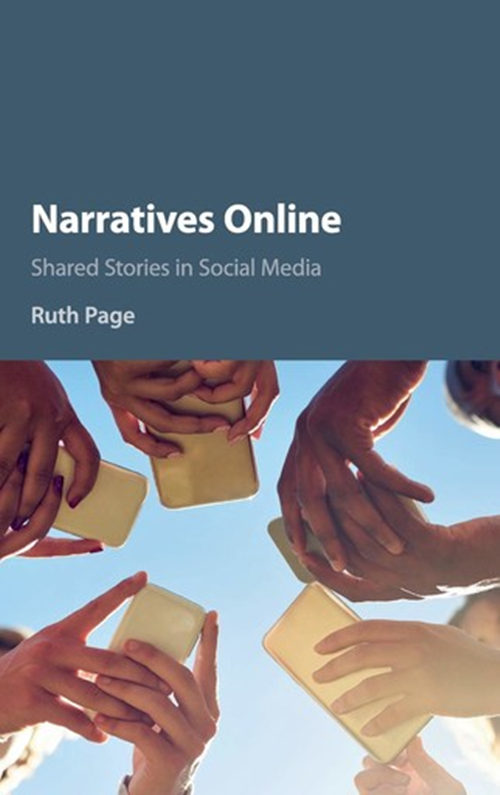


Affordance in social media shaping online narratives

Ruth Page Photo: PROVIDED TO CSST

Narratives Online: Shared Stories in Social Media (2018) authored by Ruth Page Photo: PROVIDED TO CSST

The characteristics of social media narratives are shaped by the affordances of different sites and platforms. Photo: TUCHONG
People have used stories for many years to make sense of themselves and the world around them. Stories are a key resource for identity work. These reasons for telling stories remain true also for stories that are told on social media sites and platforms. People engage with these stories for a range of reasons. They might be connecting with their friends, following a celebrity, influencer or brand, interested in a political issue or wanting to debate with others. They may engage with the story to raise their own visibility, to share their own stories in response or to disagree and protest about the story that has been told. There are benefits to engaging with these stories: they may give voice to those stories that are marginalized or not heard through mainstream media outlets, as in the case of citizen journalism. They may raise awareness of social justice issues, as in the case of #MeToo stories. They may provide support and foster solidarity. Equally, stories may be instrumentalized in political communication, may over-simplify complex situations or used as a marketing ploy for financial gain.
Characteristics of social media narratives
The characteristics of social media narratives are shaped by the affordances of different sites and platforms. For example, the update prompts in social networks which encouraged site members to post updates about what they were doing “right now,” increased the practices of “sharing the moment” and present-tense narration of “breaking news.” The relative permanence of the text (e.g. how long it may be viewed publicly in the feed of a particular account or site) also may impact the “tellability” of a story. For example, on Instagram, the difference in content curated in the posts might be more polished than the mundane or “behind the scenes” narratives published in a story. The evolution of camera-first apps, such as SnapChat and video-sharing platforms like Douyin and TikTok means that the modes of storytelling on social media are increasing multimodal: music, sounds, and images may play important roles in social media narration.
One of the key characteristics of social media content is the ways in which it can be readily reposted, remixed, and “go viral,” which means that retelling and rescripting stories has become available to a much wider number of people than in mainstream media outlets. In terms of research design, the scale, multimodality, and fast-paced changes in technology mean that we need a variety of approaches. The “small story paradigm,” led by Alexandra Georgakopoulou in Small Stories, Interaction and Identities (2007), has gained particular traction, and was the springboard for my own work in Mediated Narrative Analysis.
Mediated Narrative Analysis
Mediated Narrative Analysis builds on earlier work in discourse-analytic narrative research. Generally, it builds on the stream of work that has applied Labovian and contextualist approaches (e.g. Living Narrative: Creating Lives in Everyday Storytelling written by Elinor Ochs and Lisa Capps, 2001) to personal storytelling in social media contexts. More specifically, it builds on the small stories paradigm, especially as this has been applied to social media contexts. The innovative aspects of Mediated Narrative Analysis include the mixed methods that may be combined approaches. Whilst the early work in small stories research tended towards small scale, qualitative projects, Mediated Narrative Analysis incorporates larger scale, quantitative dimensions of research, especially using corpus-assisted discourse analysis as a way into exploring the data under scrutiny.
The commercialization of storytelling is strongly evident in marketing techniques (as in Donald Miller’s (2017) model of StoryBranding in Building a StoryBrand: Clarify Your Message So Customers Will Listen). More generally, the monetization of social media interactions and the evolution of the attention economy means that storytelling is also used in the service of self-branding. A key focus is the way that influencers use stories to increase their relatability (Page, forthcoming) either through telling personal anecdotes as the basis for product recommendations, or to give back-stage access to the influencer’s “everyday life.” In this sense, the commercial implications of telling a story about a particular product are carefully integrated into a curated life-stream of the influencer’s activities.
Impacts of AI and algorithmic storytelling
Both the rise of AI and the algorithmic nature of storytelling impact the ways in which stories are produced and consumed. Firstly, they point to the semi-automated forms of co-tellership that are emerging. In the case of AI, this incorporates the editorial as well as authorial aspects of narration which may be more or less hidden. In the case of algorithmic storytelling, the role of meta-data and human interactions with technology impact the ways in which stories may gain visibility and the companies who may gain value from observing those interactions.
The study of social media narratives has been evolving for the last 15 years. The key findings in the field relate to the ways in which storytelling is shaped by media affordances. This has included an increase in recency and telling stories about the present, or near present events. It has also focused on the ways in which tellers present themselves and debates about how authenticity as a central characteristic of identity is played out. Lastly, social media narrative studies have found that a multimodal approach is needed to make sense of these forms of storytelling. In the near future, we will see more research emerging across international contexts, more research paying attention to the short-form video and more research engaging with the real-world consequences of these stories in healthcare, politics, and economics. I anticipate that we’ll see increasing interdiscursivity where story genres will be blended in creative ways.
As a discourse analyst, I am interested in the way that people make sense of stories, how humans use technology, and the questions we might ask about the ends to which stories are put. As such, I would see stories told in social media less as having potential for transmitting more certainties but more as a prompt for people to ask critical questions about what a story might tell them.
Stories provide people with the opportunity for connection. Scholars like Harvey Sacks recognized this in the pre-digital age, describing how people tell “second stories” to show their alignment with another teller. So too in social media people connect with stories that they find relatable, or which unites them with a common social narrative. But in-groups exclude others who do not share the same common ground, stance, or identity attributes. It’s possible to feel distanced from, excluded, or take exception to the story that another person tells. The power dynamics between the tellers and the stories that might present opposing accounts of events (e.g. as in a court of law, or in different media outlets, or used in political debates) can be complex: some stories may become more visible and serve the interests of those in power, while others function as counter narratives. Polarization may be necessary in some contexts. But if we are to move towards collective action to address global challenges, we must learn better how to listen to stories that are told in ways that are difficult for us to hear, to understand what work those stories accomplish in different socio-political contexts, and ask what next needs to be done.
Ruth Page is a professor in Applied Linguistics and a Program Director at the University of Birmingham.
Editor:Yu Hui
Copyright©2023 CSSN All Rights Reserved